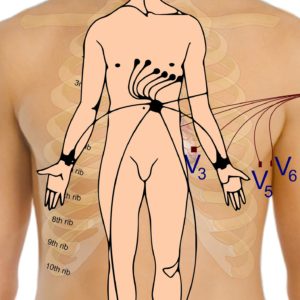Menu
Electrocardiogram
An electrocardiogram is a simple and non-invasive test during which electrodes are placed on the chest, the arms and the legs to record the electrical activity of your heart. This test takes 5 minutes and no preparation is required.
The test gives important information about the condition of your heart and your heart rhythm.
An electrocardiogram involves recording heart activity by measuring the electrical differential between 2 separate points on the heart. In practical terms, 12 to 15 electrodes are stuck to the chest, the arms and the legs (shaved beforehand to facilitate the electrical connection), then a monitor connected to the electrodes is switched on to observe the activity of the heart in real time.
The test lasts around 5 minutes and does not require any particular preparation.
Like a seismograph, in this case the screen displays a sinusoidal curve that takes shape before your eyes and accurately depicts the pulses in your heart. The heart rhythm specialist therefore obtains a curve which can be analysed in order to make a medical diagnosis.
This test allows our heart rhythm specialists to:
study the heart rhythm
define the heart rhythm (normal / presence of arrhythmias / …)
visualise the amplitude and power of the heart
Depending on the result, the heart rhythm specialist then has the necessary information to make a diagnosis.
The first electrocardiogram was created in 1887 thanks to the doctor and physiologist Augustus Désiré Waller. Since then, electrocardiograms have progressed considerably and now these tests can be carried out inexpensively, making heart rhythm analysis accessible to all.
En pratique, l’électrocardiogramme enregistre une activité cardiaque en mesurant le différentiel électrique entre 2 points  distants sur le coeur.
distants sur le coeur.
Tout d’abord, on positionne 10 électrodes, sur la poitrine, sur les bras et sur les jambes. Ensuite, ces électrodes sont reliées à un moniteur qui permet d’observer l’activité du coeur en temps réel.
En principe, cela dure environ 5 minutes et ne requiert aucune préparation particulière.
Ainsi, à l’image d’un sismographe, l’écran affiche une courbe reprenant fidèlement les pulsations cardiaques de votre coeur.
Pour finir, on imprime le tracé de l’électrocardiogramme qui est une sorte de “photographie électrique” de votre coeur.